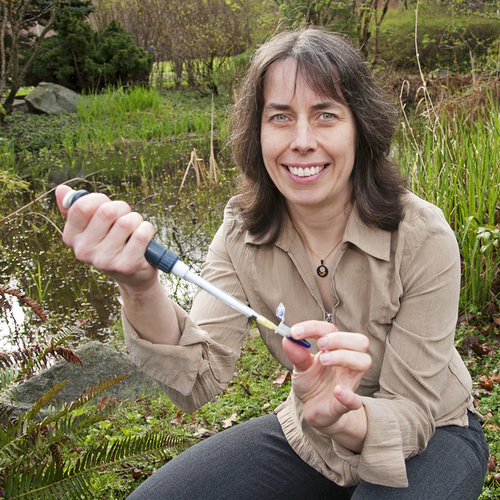Exploring eDNA

Dr. Caren Helbing of the University of Victoria heads a research project exploring eDNA in environmental monitoring. — Photo courtesy UVic photo servi
Dr. Caren Helbing of the University of Victoria heads a research project exploring eDNA in environmental monitoring. — Photo courtesy UVic photo services
Through its Ignite Program, the BC Innovation Council (BCIC) chooses market-driven research projects to fund in British Columbia. These range across industries, but all are created to solve a specific problem that an industry partner presents. Dr. Caren Helbing, professor of biochemistry and microbiology at the University of Victoria, was approached by Hemmera Envirochem and Maxxam Analytics to explore environmental monitoring techniques. Their project was awarded $185,000 with a three-year deadline.
Dr. Helbing’s mission is to explore methods of collecting, processing and evaluating environmental DNA (eDNA) in order to understand the species in a proposed project area—specifically, threatened and endangered species. When applied to the mining and energy industries, these processes will supply more accurate environmental assessments when developing a project.
The traditional methods being used in project development involve a biologist trying to find evidence of an endangered species after being flown out to an area. This can lead to logistical problems and limitations depending on factors such as the time of year. “It’s quite difficult to get accurate information,” Dr. Helbing said. “Particularly for the mining and energy sector, those are questions that need to be answered reliably for land use decisions, and for regulatory purposes.”
The general method of examining eDNA is similar to current forensics techniques, except it is applied in a new way. “The neat thing about environmental DNA is that these animals that are hard to find do leave traces of themselves in the form of sloughed-off DNA,” said Dr. Helbing. “We can measure that in a water sample with a high degree of accuracy.” This means accuracy in terms of the animal’s presence, but also how the animals are distributed throughout the area.
The first step is to narrow in on a specific methodology. “We have several versions of this approach that are working really well right now,” Dr. Helbing said. The next goal is to standardize the process, and pass the knowledge on to commercial service providers in the industry.
Dr. Helbing is currently working with Maxxam Analytics in the area of standardization. “They’ve been doing a lot of forensics already, but environmental DNA requires specific approaches that are not part of the usual way of doing things in a forensic sense,” she said. “We are transferring that know-how to them, as well as developing a standard methodology that then other service providers can use.” Within three years, the result will be a robust, reliable and regulated process that others can access.
Measuring eDNA requires following several steps. First, a trained person collects water samples in the area of interest, then filters the samples. The eDNA is trapped on the filter, which is preserved and brought to the lab. The eDNA is removed from the filter, and tested to isolate the DNA for its ability to amplify—essentially measuring its reliability as a sample. Then lab workers test for the presence of the species of interest. The process used is polymerase chain reaction (PCR).
“That technique is extremely sensitive when used properly,” Dr. Helbing said, which means that incorrect execution can result in a lot of false positives and false negatives. However, it is more reliable than traditional techniques when applied properly.
Right now, there is a significant need for making sure the technology that is used is designed in a way that those false negatives and positives are reduced to a small percentage, despite the current excitement around the technology. “That’s where my lab comes in,” said Dr. Helbing. “We’ve been using PCR and related techniques since they were invented, so several decades now.” Her lab brings expertise and innovative design characteristics that have produced a methodology reducing false negatives and positives.
Dr. Helbing is particularly interested in the well-being of animals, their environment, and therefore people living near by. “My lab is interested in applying molecular techniques that tell you something about the health of an animal,” she said. “I’m trying to develop tests, preferably non-lethal tests, for looking at wildlife in various contexts to evaluate the level of pollution as indicators of environmental health and human health.” This information has the potential to measure how a project has disrupted an area, and what that means for those living close by.



